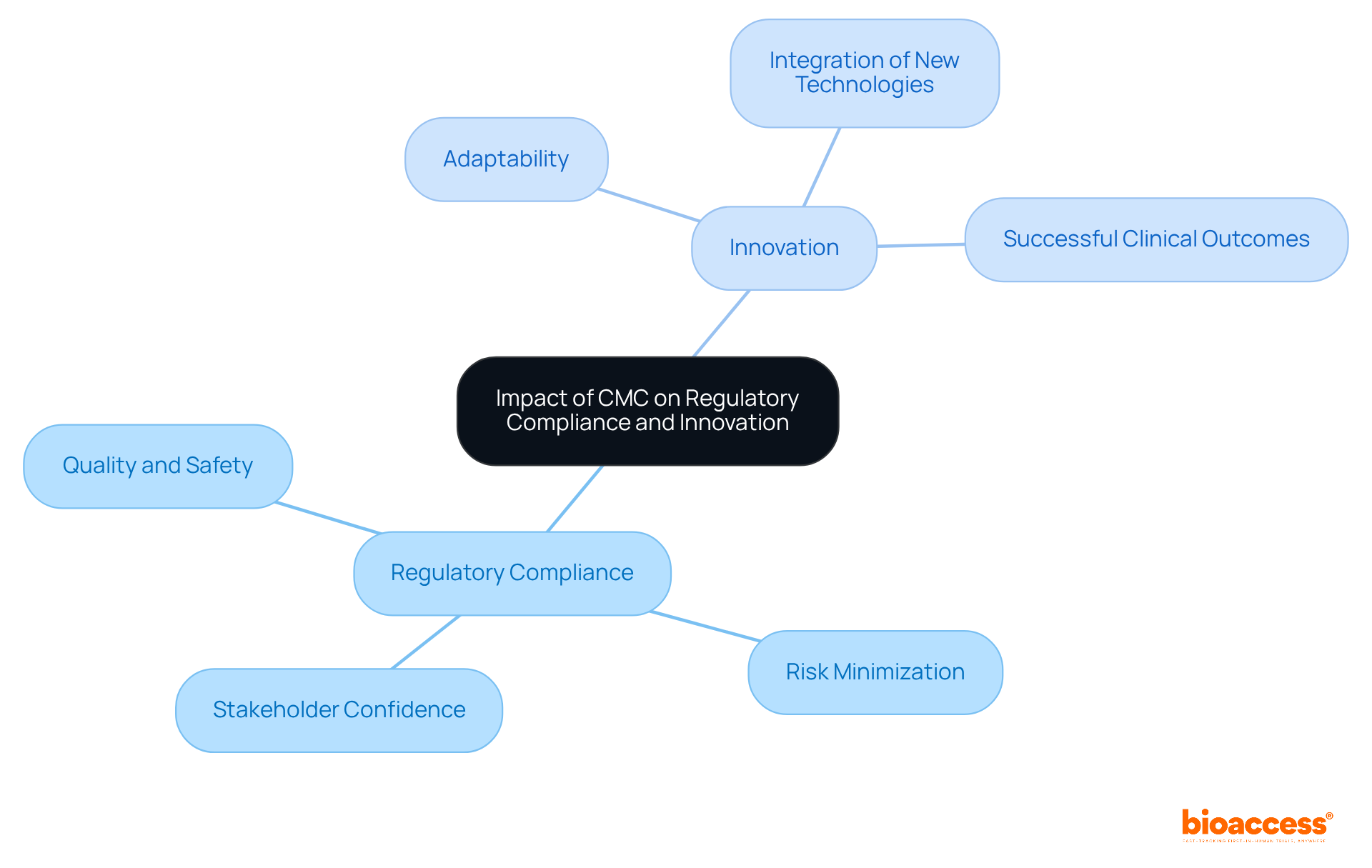


The term CMC, which stands for Chemistry, Manufacturing, and Controls, plays a pivotal role in clinical research by ensuring the quality, safety, and efficacy of pharmaceutical products throughout their development lifecycle. Effective CMC practices are not merely beneficial; they are crucial for regulatory compliance and for minimizing risks in clinical trials.
By establishing rigorous standards for:
CMC ultimately protects patient safety and fosters trust in new therapies. As such, understanding and implementing robust CMC practices is essential for all stakeholders in the Medtech landscape.
Understanding the intricate world of pharmaceutical development reveals a pivotal element known as Chemistry, Manufacturing, and Controls (CMC). This essential framework ensures not only the quality and safety of medicinal products but also plays a crucial role in the regulatory landscape of clinical research. As the industry grapples with the challenges of compliance and innovation, one must consider: how does a robust understanding of CMC shape the future of drug development and patient safety? Exploring the nuances of CMC provides valuable insights into its critical impact on clinical trials and the broader pharmaceutical sector.
Chemistry, Manufacturing, and Controls (CMC) is a crucial element of pharmaceutical development, and it is important to know what does cmc stand for, as it encompasses the processes and activities that ensure the quality, safety, and effectiveness of medicinal products throughout their lifecycle. CMC establishes the specifications for both the active ingredient and the final formulation, detailing the manufacturing processes and quality assurance measures necessary for compliance with regulatory standards. This includes a comprehensive analysis of the chemical properties of active ingredients, the methodologies used in production, and the stringent quality assurance protocols that must be adhered to.
In clinical research, one cannot overstate the importance of understanding what does cmc stand for. It plays a vital role in protecting human health by ensuring that investigational drugs are not only effective but also safe for use. For example, a study demonstrated that robust CMC practices can significantly reduce the likelihood of adverse events in clinical trials, thereby enhancing patient safety and fostering trust in new therapies.
Real-world instances underscore the significance of CMC processes. The FDA's approval of a new biopharmaceutical frequently depends on the strength of its CMC data, which illustrates that the product meets rigorous quality standards. Companies that prioritize CMC are better positioned to navigate compliance challenges and achieve successful market entry.
In conclusion, understanding what does cmc stand for is crucial for professionals in the pharmaceutical industry, as it directly impacts development timelines, regulatory compliance, and ultimately, patient safety.

The evolution of Chemistry Manufacturing and Controls (CMC) regulations, which leads us to ask what does CMC stand for, has been transformative since the inception of therapeutic development. Initially, the emphasis was primarily on the discovery of active pharmaceutical ingredients, with manufacturing processes receiving scant attention. However, as the pharmaceutical landscape expanded and regulatory agencies such as the FDA and EMA instituted more stringent guidelines, it became increasingly evident what does CMC stand for.
The introduction of Good Manufacturing Practices (GMP) in the 1960s marked a pivotal moment, underscoring the necessity for stringent quality control in medication production. This shift not only enhanced the safety and efficacy of pharmaceutical products but also established a framework for consistent manufacturing practices. Over the decades, technological advancements and a deeper understanding of drug formulation have further refined CMC practices, leading many to ask what does CMC stand for and solidifying their essential role in the drug development continuum.
Case studies illustrate how adherence to GMP has directly influenced CMC practices, resulting in improved compliance and quality of goods. The timeline of CMC regulations reflects a growing recognition of their significance, particularly in understanding what does CMC stand for, transforming the pharmaceutical industry into a more regulated and quality-focused sector.
For instance, Niamh Lawler Turner’s career trajectory, which commenced at Astra during its merger with Zeneca, exemplifies the impact of evolving regulatory practices on professional development within the field. Her establishment of PharmaFind Limited underscores the practical implications of CMC regulations in aiding companies with licensing medicines in Europe. Furthermore, insights from industry professionals accentuate the importance of these regulations in ensuring quality and compliance, reinforcing the narrative of CMC's evolution.

The key components of CMC, which is what does cmc stand for, encompass several essential elements that ensure the successful development and approval of pharmaceutical products.
Drug Substance Characterization is the first critical step, involving a comprehensive analysis of the chemical and physical properties of the active pharmaceutical ingredient (API). Effective characterization is crucial for ensuring the API's quality, consistency, and suitability for clinical use. Understanding the solid-state properties of the API can significantly impact its bioavailability and overall performance in later stages of development.
Next, Manufacturing Process Development plays a vital role. Establishing strong manufacturing procedures is essential for consistently creating pharmaceutical items that meet stringent quality standards. Current trends emphasize the importance of early-phase preparations, as inadequate planning can lead to significant delays and increased costs. For instance, Anxious, LLC faced challenges due to limited API manufacturing experience, which resulted in variability in exposure during first-in-human studies.
Quality Control and Assurance follow closely behind, where rigorous testing and validation protocols are implemented to ensure that both the drug substance and drug formulation meet predefined specifications. This includes analytical methods that are phase-appropriate and stability-indicating, essential for maintaining item integrity throughout the development process.
Finally, Regulatory Compliance is paramount. It is critical to prepare and submit comprehensive CMC documentation to regulatory authorities to clarify what does cmc stand for. This documentation demonstrates that the item meets all safety and efficacy requirements. The FDA's guidance on IND applications highlights the necessity of clear communication regarding CMC information, which is essential for facilitating the approval process.
Each of these components plays a vital role in ensuring that clinical trials can proceed smoothly and that investigational products are safe for participants. As the pharmaceutical sector continues to adapt to competitive pressures and compliance changes, a strategic emphasis on CMC will be crucial for successful medication development.

The effect of CMC, or what does CMC stand for, on compliance with regulations is profound. Efficient CMC practices guarantee that all components of drug development conform to compliance standards, leading to the important question of what does CMC stand for in relation to minimizing the risk of delays in clinical trials and market entry. By maintaining high standards of quality and safety, CMC not only facilitates compliance but also prompts the inquiry of what does CMC stand for in fostering innovation.
Firms such as Bioaccess, which invest in robust CMC strategies—including:
can more easily adapt to new guidelines and integrate innovative technologies into their manufacturing processes, prompting the inquiry of what does CMC stand for. This adaptability is crucial in a rapidly evolving pharmaceutical landscape, where the demand for new therapies continues to rise. Furthermore, understanding what does CMC stand for can enhance stakeholder confidence through a strong CMC framework, ultimately leading to more successful clinical outcomes. Katherine Ruiz, an expert in regulatory affairs for medical devices and in vitro diagnostics in Colombia, exemplifies the importance of having knowledgeable professionals guiding these processes.

Understanding the significance of Chemistry, Manufacturing, and Controls (CMC) is essential for anyone involved in the pharmaceutical industry. CMC encompasses a wide array of processes that ensure the safety, efficacy, and quality of medicinal products, directly influencing drug development and regulatory compliance. By grasping what CMC stands for, professionals can better navigate the complexities of clinical trials and contribute to the advancement of safe therapies.
The article highlights several key aspects of CMC, including:
From the introduction of Good Manufacturing Practices to the meticulous processes involved in drug substance characterization, manufacturing process development, quality control, and regulatory compliance, each element plays a pivotal role in ensuring that investigational drugs meet the highest standards. The examples provided illustrate how robust CMC practices can mitigate risks and enhance patient safety, fostering trust in new medical therapies.
In a rapidly changing pharmaceutical landscape, prioritizing CMC is not merely beneficial; it is imperative. As the demand for innovative therapies grows, so does the need for stringent CMC practices that can adapt to evolving regulations and technologies. Emphasizing CMC not only enhances compliance but also drives innovation, ultimately leading to better clinical outcomes. Engaging with CMC processes is a call to action for all stakeholders in the pharmaceutical field to ensure that the development of new medications remains safe, effective, and compliant with regulatory standards.
What does CMC stand for in the context of clinical research?
CMC stands for Chemistry, Manufacturing, and Controls, which encompasses the processes and activities ensuring the quality, safety, and effectiveness of medicinal products throughout their lifecycle.
Why is CMC important in pharmaceutical development?
CMC is important because it establishes specifications for active ingredients and final formulations, detailing manufacturing processes and quality assurance measures necessary for compliance with regulatory standards.
How does CMC contribute to patient safety in clinical trials?
Robust CMC practices help ensure that investigational drugs are effective and safe for use, significantly reducing the likelihood of adverse events in clinical trials and enhancing patient safety.
What role does CMC data play in FDA approvals?
The FDA's approval of a new biopharmaceutical often depends on the strength of its CMC data, which demonstrates that the product meets rigorous quality standards.
How can prioritizing CMC benefit pharmaceutical companies?
Companies that prioritize CMC are better positioned to navigate compliance challenges, which can lead to successful market entry and faster development timelines.
What impact does understanding CMC have on professionals in the pharmaceutical industry?
Understanding CMC is crucial for pharmaceutical professionals as it directly impacts development timelines, regulatory compliance, and ultimately, patient safety.